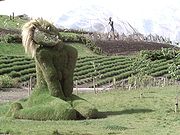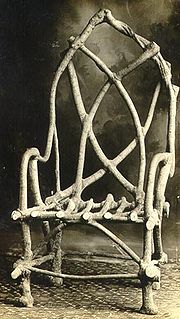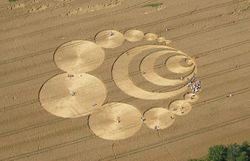
Living sculpture
Encyclopedia
Living sculpture is any type of sculpture
that is created with living, growing grass
es, vine
s, plants or tree
s. It can be functional and/or ornamental. There are several different types of living sculpture techniques, including topiary
(prune plants or train them over frames), sod works (create sculptures using soil and grass or moss), tree shaping (growing designs with living trees) and mowing and crop art (create patterns or pictures with plants or in lawns). Most living sculpture technique requires horticultural
skills, such as grafting
or pruning
, to create the art.
or topiary have long historical traditions), its recent rediscovery by artists, horticulturalists, gardeners, and young people has given living sculpture an innovative popularity.
Living sculpture offers a highly appealing blend of art and science. It’s a creative process that gives the sculptor a chance to bring their own unique vision to life (literally!) Creating a living sculpture is also a collaborative process that can bring artistic minds, logistical minds, and scientific minds together. As a team project, creating a living sculpture can be about more than just art or science. A team collaborating to design and build a living sculpture can learn a lot about themselves, each other, and what partnerships are all about - while making a functional and/or ornamental public sculpture in their community.
 One of the older and more familiar kinds of living sculpture, topiary
One of the older and more familiar kinds of living sculpture, topiary
is the art of growing dense, leafy plants and pruning them into a form, or training them over a frame, to create a three-dimensional object. It relies on pruning and training to give shape to an existing plant. It also can involve training a plant to fill in a form.
Topiary is one type of living sculpture that has gone in and out of favor through the ages. A few historical highlights of its importance and use:
is the art of aesthetic miniaturization of trees, or of developing woody or semi-woody plants shaped as trees, by growing them in containers. Cultivation includes techniques for shaping, watering, and repotting in various styles of containers.
 Turf- or sod-works are created from grass or moss and soil. This type of art has roots in the Land Art movement (also known as the Earthworks or Earth Art movement) that emerged in the late 1960s and early 1970s. During this period, landscape and the work of art began to be viewed as linked. Sculptures were not just placed in the landscape; rather the landscape became the very means of their creation. These works often existed in the open, located well away from communities, and were left to change under natural conditions. Many of the first works were created in the deserts of Nevada, Utah, New Mexico, and Arizona. They did not, or were not meant to last, and now exist only as recordings or photos.
Turf- or sod-works are created from grass or moss and soil. This type of art has roots in the Land Art movement (also known as the Earthworks or Earth Art movement) that emerged in the late 1960s and early 1970s. During this period, landscape and the work of art began to be viewed as linked. Sculptures were not just placed in the landscape; rather the landscape became the very means of their creation. These works often existed in the open, located well away from communities, and were left to change under natural conditions. Many of the first works were created in the deserts of Nevada, Utah, New Mexico, and Arizona. They did not, or were not meant to last, and now exist only as recordings or photos.
Works made from the earth are changing the way in which people view art, and often are used to promote environmental awareness. These works may be created on waste sites, and may draw attention to land reclamation and urban restoration efforts. Recent earth artists have worked with soil, sod, or moss to create forms that may be intimate and small, or large and multi-acre. They may be cut out of the earth, or formed with soil. They may give a nod to the past, or they may be cutting edge and contemporary in design. Some examples include labyrinths and mazes, animal and human forms, geometric shapes, and furniture.

Chairs, ladders and other shapes made from living trees are some examples of tree shaping. Some types of tree shaping involve horticultural practices such as weaving, grafting, training, and/or shaping young, living trees into desired shapes.
 Crop artists plan in advance on paper, and often work with farmers, special equipment, and a diversity of crops to create multi-acre masterpieces that are viewed from the air and are captured via photographs. They draw on a variety of impressionist
Crop artists plan in advance on paper, and often work with farmers, special equipment, and a diversity of crops to create multi-acre masterpieces that are viewed from the air and are captured via photographs. They draw on a variety of impressionist
, surrealist
, and modernist roots in their designs, and some are downright quirky: http://www.gardenrant.com/my_weblog/images/elvis.jpg. Stan Herd is a renowned Crop artist
.
Tree Shaping
Tree Sculpture
Creative Mowing & Crop Art
Turf or Sod Works
Tree Shaping
Creative Mowing & Crop Art
Sculpture
Sculpture is three-dimensional artwork created by shaping or combining hard materials—typically stone such as marble—or metal, glass, or wood. Softer materials can also be used, such as clay, textiles, plastics, polymers and softer metals...
that is created with living, growing grass
Grass
Grasses, or more technically graminoids, are monocotyledonous, usually herbaceous plants with narrow leaves growing from the base. They include the "true grasses", of the Poaceae family, as well as the sedges and the rushes . The true grasses include cereals, bamboo and the grasses of lawns ...
es, vine
Vine
A vine in the narrowest sense is the grapevine , but more generally it can refer to any plant with a growth habit of trailing or scandent, that is to say climbing, stems or runners...
s, plants or tree
Tree
A tree is a perennial woody plant. It is most often defined as a woody plant that has many secondary branches supported clear of the ground on a single main stem or trunk with clear apical dominance. A minimum height specification at maturity is cited by some authors, varying from 3 m to...
s. It can be functional and/or ornamental. There are several different types of living sculpture techniques, including topiary
Topiary
Topiary is the horticultural practice of training live perennial plants, by clipping the foliage and twigs of trees, shrubs and subshrubs to develop and maintain clearly defined shapes, perhaps geometric or fanciful; and the term also refers to plants which have been shaped in this way. It can be...
(prune plants or train them over frames), sod works (create sculptures using soil and grass or moss), tree shaping (growing designs with living trees) and mowing and crop art (create patterns or pictures with plants or in lawns). Most living sculpture technique requires horticultural
Horticulture
Horticulture is the industry and science of plant cultivation including the process of preparing soil for the planting of seeds, tubers, or cuttings. Horticulturists work and conduct research in the disciplines of plant propagation and cultivation, crop production, plant breeding and genetic...
skills, such as grafting
Grafting
Grafting is a horticultural technique whereby tissues from one plant are inserted into those of another so that the two sets of vascular tissues may join together. This vascular joining is called inosculation...
or pruning
Pruning
Pruning is a horticultural practice involving the selective removal of parts of a plant, such as branches, buds, or roots. Reasons to prune plants include deadwood removal, shaping , improving or maintaining health, reducing risk from falling branches, preparing nursery specimens for...
, to create the art.
History
Sculptors through the ages have traditionally worked with non-living media such as clay, plaster, glass, bronze, or even plastic. Although sculpting plants isn’t a new idea (bonsaiBonsai
is a Japanese art form using miniature trees grown in containers. Similar practices exist in other cultures, including the Chinese tradition of penjing from which the art originated, and the miniature living landscapes of Vietnamese hòn non bộ...
or topiary have long historical traditions), its recent rediscovery by artists, horticulturalists, gardeners, and young people has given living sculpture an innovative popularity.
Living sculpture offers a highly appealing blend of art and science. It’s a creative process that gives the sculptor a chance to bring their own unique vision to life (literally!) Creating a living sculpture is also a collaborative process that can bring artistic minds, logistical minds, and scientific minds together. As a team project, creating a living sculpture can be about more than just art or science. A team collaborating to design and build a living sculpture can learn a lot about themselves, each other, and what partnerships are all about - while making a functional and/or ornamental public sculpture in their community.
Topiary

Topiary
Topiary is the horticultural practice of training live perennial plants, by clipping the foliage and twigs of trees, shrubs and subshrubs to develop and maintain clearly defined shapes, perhaps geometric or fanciful; and the term also refers to plants which have been shaped in this way. It can be...
is the art of growing dense, leafy plants and pruning them into a form, or training them over a frame, to create a three-dimensional object. It relies on pruning and training to give shape to an existing plant. It also can involve training a plant to fill in a form.
Topiary is one type of living sculpture that has gone in and out of favor through the ages. A few historical highlights of its importance and use:
- Earliest references of topiary date back to 23-79 A.D.
- It was immensely popular in Ancient RomeAncient RomeAncient Rome was a thriving civilization that grew on the Italian Peninsula as early as the 8th century BC. Located along the Mediterranean Sea and centered on the city of Rome, it expanded to one of the largest empires in the ancient world....
using cypress trees, but after the fall of Rome, topiary fell out of favor for several hundred years. - It returned in medieval times as a way of training fruit plants, and then was again rediscovered during the Italian RenaissanceItalian RenaissanceThe Italian Renaissance began the opening phase of the Renaissance, a period of great cultural change and achievement in Europe that spanned the period from the end of the 13th century to about 1600, marking the transition between Medieval and Early Modern Europe...
. - The Dutch in the 15th century became intrigued with creating topiary in animal shapes, as did 17th century England; the French preferred creating topiary in geometric designs with strict symmetry.
- 18th century, topiary fell out of favor again, and a natural look returned.
- VictoriansVictorian eraThe Victorian era of British history was the period of Queen Victoria's reign from 20 June 1837 until her death on 22 January 1901. It was a long period of peace, prosperity, refined sensibilities and national self-confidence...
brought back topiary, adding in new plants and details. - Topiary spread to North America at Williamsburg, Virginia, around 1690.
- As houseplants became popular in the 1950s and 1960s, topiary moved indoors.
Bonsai
BonsaiBonsai
is a Japanese art form using miniature trees grown in containers. Similar practices exist in other cultures, including the Chinese tradition of penjing from which the art originated, and the miniature living landscapes of Vietnamese hòn non bộ...
is the art of aesthetic miniaturization of trees, or of developing woody or semi-woody plants shaped as trees, by growing them in containers. Cultivation includes techniques for shaping, watering, and repotting in various styles of containers.
Turf and sodworks

Works made from the earth are changing the way in which people view art, and often are used to promote environmental awareness. These works may be created on waste sites, and may draw attention to land reclamation and urban restoration efforts. Recent earth artists have worked with soil, sod, or moss to create forms that may be intimate and small, or large and multi-acre. They may be cut out of the earth, or formed with soil. They may give a nod to the past, or they may be cutting edge and contemporary in design. Some examples include labyrinths and mazes, animal and human forms, geometric shapes, and furniture.
Tree shaping

Chairs, ladders and other shapes made from living trees are some examples of tree shaping. Some types of tree shaping involve horticultural practices such as weaving, grafting, training, and/or shaping young, living trees into desired shapes.
Creative Mowing and Crop Art

Impressionism
Impressionism was a 19th-century art movement that originated with a group of Paris-based artists whose independent exhibitions brought them to prominence during the 1870s and 1880s...
, surrealist
Surrealism
Surrealism is a cultural movement that began in the early 1920s, and is best known for the visual artworks and writings of the group members....
, and modernist roots in their designs, and some are downright quirky: http://www.gardenrant.com/my_weblog/images/elvis.jpg. Stan Herd is a renowned Crop artist
Crop art
Crop art falls into several different categories, all of which employ land and/or what grows from it to create images.-Seed art:One version of Crop art is also called Seed art, a visual art created in mosaic-style. Mosaic is an ancient technique of making designs, often from bits of tile or...
.
See also
- Axel ErlandsonAxel ErlandsonAxel Erlandson was a Swedish American farmer who shaped trees as a hobby, and opened a horticultural attraction in 1947 advertised as "See the World's Strangest Trees Here," and named "The Tree Circus."...
- Crop circles
- Earthworks
- EspalierEspalierEspalier is the horticultural and ancient agricultural practice of controlling woody plant growth by pruning and tying branches so that they grow into a flat plane, frequently in formal patterns, against a structure such as a wall, fence, or trellis, and also plants which have been shaped in this...
- Gilroy GardensGilroy GardensGilroy Gardens is a garden-themed family theme park in Gilroy, California and current location of the world-famous Circus Trees created by Axel Erlandson. It was founded by Michael and Claudia Bonfante after selling their Nob Hill Foods supermarket chain to build the park. The park was constructed...
- John KrubsackJohn KrubsackJohn Krubsack was a banker and naturalist from Embarrass, Wisconsin. He conceived, planted and shaped living trees to create the first known grown chair...
- TopiaryTopiaryTopiary is the horticultural practice of training live perennial plants, by clipping the foliage and twigs of trees, shrubs and subshrubs to develop and maintain clearly defined shapes, perhaps geometric or fanciful; and the term also refers to plants which have been shaped in this way. It can be...
- Tree shaping
- PleachingPleachingPleaching is a technique to weave the branches of trees into a hedge or to form a quincunx. Commonly, deciduous trees are planted in lines, then pleached to form a flat plane on clear stems above the ground level. Branches are woven together and lightly tied...
- Crop artCrop artCrop art falls into several different categories, all of which employ land and/or what grows from it to create images.-Seed art:One version of Crop art is also called Seed art, a visual art created in mosaic-style. Mosaic is an ancient technique of making designs, often from bits of tile or...
Further reading
Topiary- The Complete Book of Topiary. Gallup, Barbara; Reich, Deborah 1987. Workman Publishing, N.Y
- Quick and Easy Indoor Topiary. Jones, Chris 1998. Storey Books; Pownal, Vermont
Tree Shaping
- Living Willow Sculpture. Warnes, Jon 2001. Search Press.
- Arborsculpture: Solutions for a small planet. Reames, Richard 2002. Arborsmith Studios.
- Tricks With Trees: Land Art for the Garden by Ivan Hicks and Richard Rosenfeld 2007
Tree Sculpture
- Making Bentwood Trellises, Arbors, Gates & Fences. Long, Jim 1998. Storey Publishing.
Creative Mowing & Crop Art
- Lawnscapes: Mowing Patterns to Make Your Yard a Work of Art. Parfitt, David 2006. Quirk Books.
- Crop Art and Other Earthworks. Herd, Stan 1994. Harry N. Abrams Publishers.
- Crop Circles: Art in the Landscape. Pringle, Lucy 2007. Frances Lincoln.
External links
Living Sculpture- The Cornell Garden-Based Learning Institute's Living Sculpture Website: http://www.hort.cornell.edu/livingsculpture
- Lovallo Living Sculpture Turf and Tree Works
Turf or Sod Works
- HGTV at Home: Sod Sofas - Landscape architect Greg Tate demonstrates how to build a sod sofa for your lawn
- Sprout a Couch: Lawn Furniture for Literalists - Article by Greg Tate in Ready Made Magazine about how to build a sod sofa.
Tree Shaping
Creative Mowing & Crop Art
- Stan Herd: Crop Art and Other Earthworks - From 160 acre (0.6474976 km²) plowed portraits to one quarter acre intimate stone designs, artist Stan Herd’s work has become a platform for discussion of mankind's contemporary relationship to the land.
- Lawn Striping and Lawn Patterns: How Do They Work? - A good explanation on how lawn striping works and what can be done to increase the lawn striping effect.

